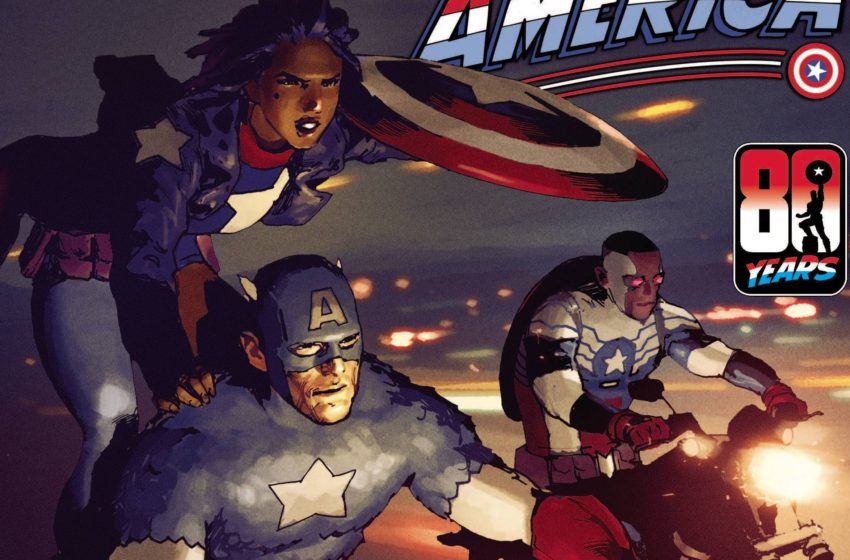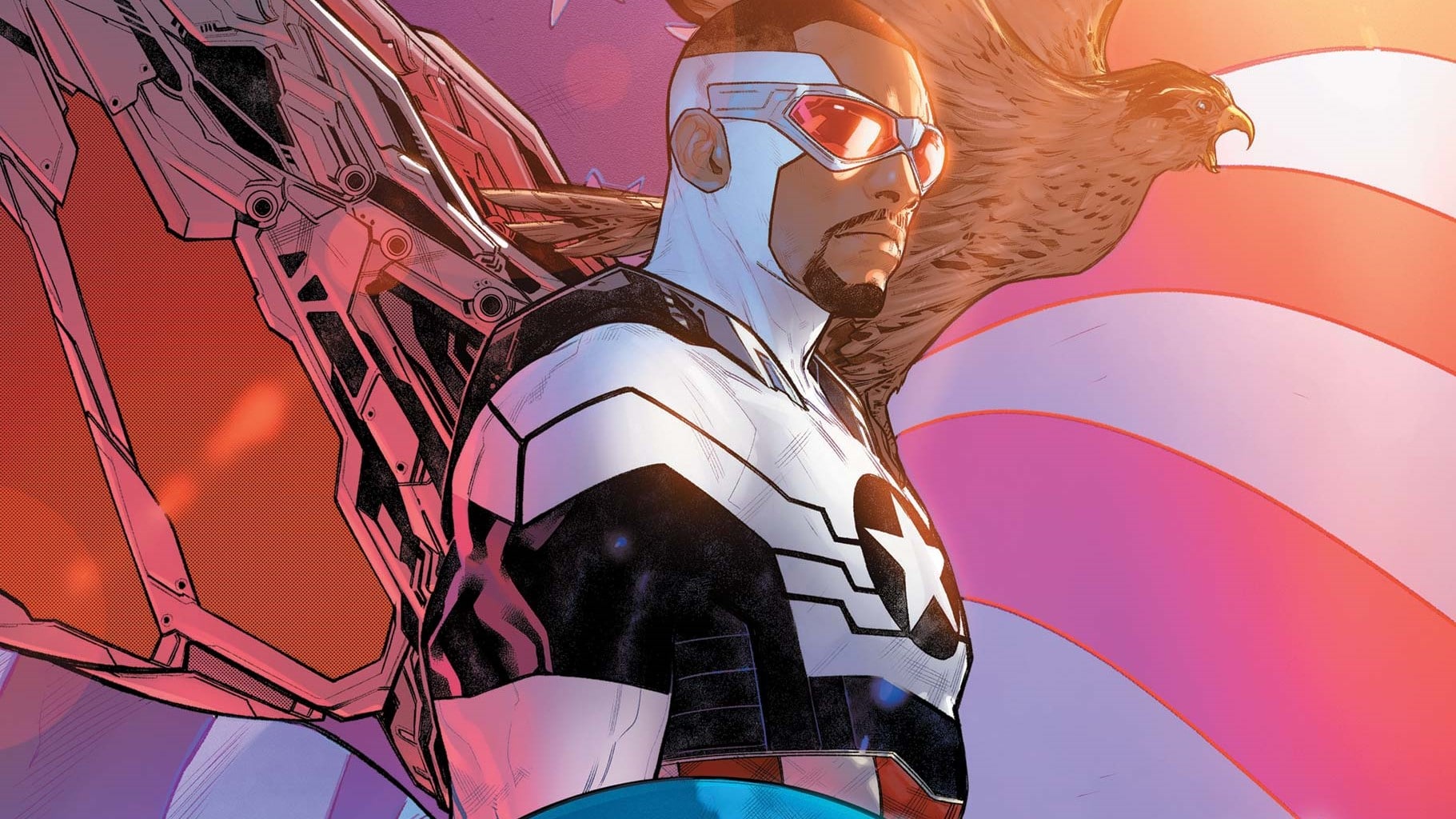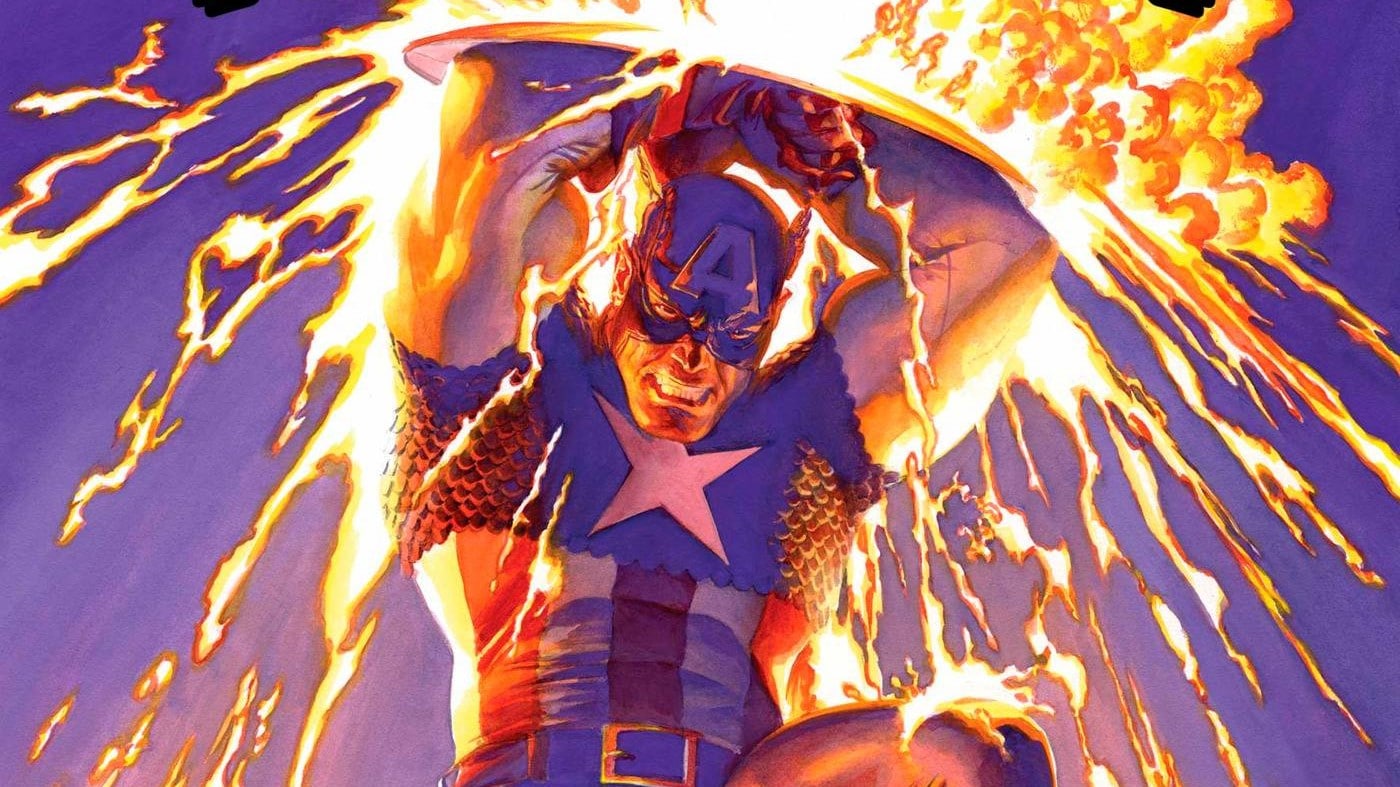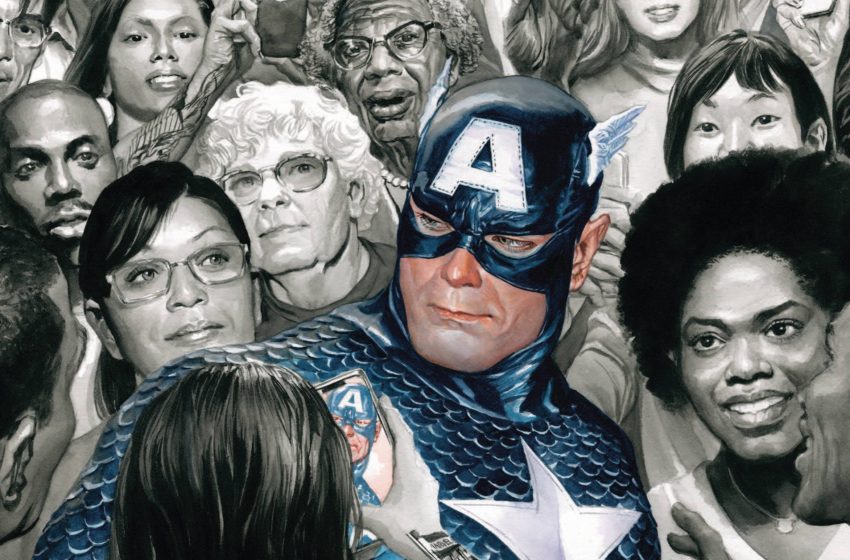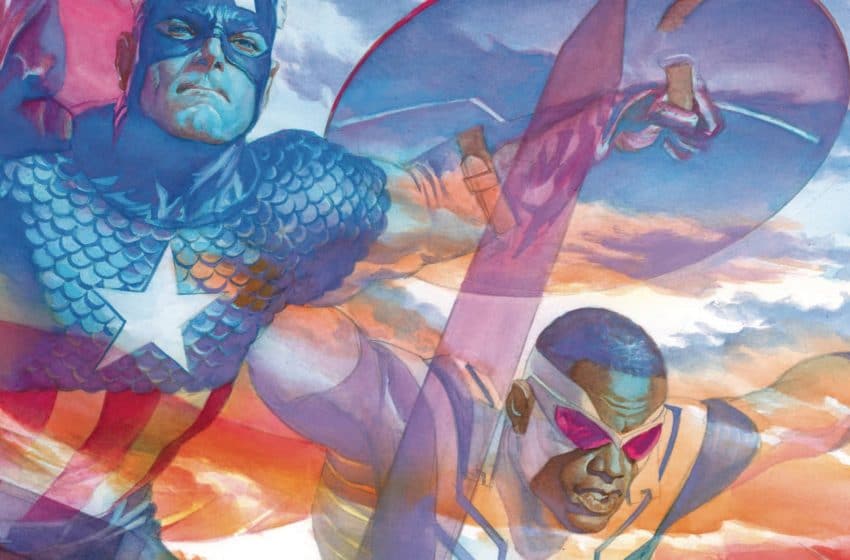O Captains, Our Captains continue their star-spangled road trip in The United States of Captain America #2. Following the trail of “The Captains Network” and their shield thieves, Captains America Steve Rogers and Sam Wilson find themselves embroiled in some good old-fashioned civil disobedience. All this and another backup story starring the new “local” Captain America! Written by Christopher Cantwell & Mohale Mashigo. Drawn by Dale Eaglesham & Natacha Bustos. Colored by Matt Milla. Lettered by Joe Caramagna.
Justin Partridge: First off, before we get to anything, I would like very much to thank my collaborator Andrea and Editor Dan for their patience and grace in starting this column off beautifully.
When this series was announced, I quickly wanted to try and write it up, but some technical difficulties kept me from debuting it properly like I wanted. Fortunately, I work with absolutely sterling writers and have an editorial board that values people over content, so I was able to enjoy the opener, both as a reader and fan of the work done here at CXF.
But now I’m back! Getting to talk to the TREMENDOUSLY SMART Andrea about a pretty fun and functional Captain America yarn! Are you as excited as I am, Andrea?
Andrea Ayres: Justin, I am very uncomfortable with you building me up like this. I hope you know how lucky I feel to be able to talk about Captain America with you. There, now that we’ve inflated one another’s egos and deflected any compliments. … Let’s get straight to the biscuits.
Justin: See? Isn’t she just the BEST, y’all?
The Man in Star-Spangled Man

Justin: So like the first issue, The United States of Captain America #2 does a lot of work trying to center Steve as a person first, symbol second.
Though I think the latter part stumbles a little bit, which we will get into later, Chris Cantwell has a really good handle on the former. We get another fun, humanizing story in the opening, told in a folksy sort of narration from Cantwell. But throughout the issue, both Steve and Sam discuss Steve more as a person than as a “superhero,” and that’s something I responded to here.
What about you, Andrea? Do you like when we get stories about the men behind the shield?
Andrea: Captain America #2 kicks off in Gettysburg, Pennsylvania. The Battle of Gettysburg cost around 3,200 lives and was a significant turning point in the Civil War. It’s, of course, famous for Abraham Lincoln’s 1863 Address. Like you, I enjoyed the story Rogers tells Wilson to open the issue about being a Cub Scout who has to pee very badly.
I love how it captures so many field trips you have as a kid where you simply cannot appreciate the space or moment you are in because you are a literal child. It’s also a subtle trick Cantwell uses to perhaps get us to reflect on why we subject children to such sanitized historical propaganda.
Rogers says to Wilson, “Lately, I wonder if we ever really came back from it.” And the answer is, of course, no. It’s impossible to come back from something you never faced in the first place.
Justin: NO, ABSOLUTELY! And though it’s obviously the sanitized version of the real history (such is the rub when in the thick of schooling), it makes so much character sense that Steve would be enthralled with it. And it is immensely charming to see such an “icon” acting in such a wholly human manner. Cantwell, I think, is really good at that sort of grounding. We get touches of it a lot in Iron Man, so it’s nice to see it making the transition over into Steve’s anniversary event, too.
Captain America: Civil Disobedience

Justin: Now THIS section I will say I half-enjoyed. I think I appreciate the intention of it more than I do the execution.
Following the trail of the shield thieves and the next ping on the “Captains Network” (provided in the opener by Captain America of the Railways, Aaron Fischer), Steve and Sam are brought into a Flint-esque town that its brush has recently shaken with a Captain. While defending an embattled water pipeline from the shield thieves, local Captain Nichelle Wright is wrongfully arrested and promptly has the book thrown at her by the backward constabulary. This, in turn, causes Steve and Sam to “break some rules” to get at the truth.
Now, on paper, I love this. The idea of Steve and Sam somewhat wielding their own clout as Captains to expose a racist police force and exonerate a fellow Cap is Good Stuff in my book. But some of the dialogue getting there came across as a touch wooden for me. Like, we have Sam straight-up calling Steve out on his privilege, which is great, but in the same exchange, we have Steve expressing discomfort at someone using his persona to “make trouble,” which is NOT great.
Is this just me, Andrea? How did this stuff grab you?
Andrea: I absolutely agree with you, Justin. I guess I just don’t want a white Steve Rogers explaining to me the value of a Black woman doing civil disobedience. I want Steve Rogers to explain why it’s essential white people step into that fight. Eventually, the issue does that, but I want to hear why from Nichelle Wright. I don’t want to have Rogers or Wilson explain it to me.
It also doesn’t read right, as you say, that like we’re getting through the action by way of marginalized people doing everything they can to protect their community, only to have it backfire and need to have Steve and Sam come in. Also, Sam’s ending up responding to the racist police chief and not Steve is uncomfortable for me. It makes me question who is putting what on the line in United States of Captain America #2? Steve gets to wax poetic about thinking about racism, but the marginalized people in the comic are the ones responding. They are also the people with the most to lose against a racist and oppressive system.
It’s not that Steve Rogers never responds. It’s just a question of how, when and the purpose behind it. If his purpose of responding is to protect the shield, the image of America, then that’s not doing the work of dismantling racist infrastructure. It’s finding a way to both-sides the “debate”? At least, that is how it’s reading to me.
Justin: NO, TOTALLY! It reads really clunky and I am glad to know it’s not just me.
It’s even weirder reading through all this after the first Steve and Sam scene. This just explicates that Steve KNOWS that his “symbol” can and will be co-opted out of his hands. A sentiment even further branched out by him LITERALLY SAYING, “You know I’ve been charged with domestic terrorism, too.” It makes the later scene when they actually MEET Nichelle feel so oddly terse. When you would THINK that Steve would truly love seeing someone standing up for the little guy as Nichelle has for her town.
I don’t know. None of this is enough to really ruin my enjoyment, but it seems a little out of character for Steve. Even supported by the opening scene. It doesn’t make much sense to me that Steve would still be somewhat uncomfortable with Nichelle after meeting her and fully realizing what she is standing for in the moment. Like you, I was a little disappointed to see Sam “running point” on that sequence with Steve only really providing support once they had moved past the uncomfortable optics of how and why Nichelle has been incarcerated.
I just feel like, especially after knowing her and seeing how she’s using being Captain America, Steve would WANT to know her. Would WANT to know her story. It just seems like a missed opportunity for connection to me.
Däs Bäddies

Justin: Another big revelation of United States of Captain America #2 is the identities of some of our shield thieves. It seems that Red Skull’s daughter Sin, now going by “Superior,” has cooked up this whole charade, and she’s Winter Soldiering some C-listers to help out. Namely Speed Demon, who has been the primary quick-footed stooge we have been following so far.
I think I am into this! Sin is an engaging, somewhat modern Cap villain that I am happy to see have a little more stage time, if only just to get Steve some proper Natzi Punchin’ time on the panel. Speed Demon is more of a deeper pull, but Cantwell has proven to be a writer who loves doing that throughout his Marvel work.
However, the idea of “attacking Steve as a symbol” seems to be a touch pedestrian. Also something we have seen a few times in Cap runs. Even in the last five to 10 years. Ta-Nehisi Coates just wrapped up an entire volume about this very thing. Mark Waid, even before him, had this element PLUS the “road movie” setup. Hell, even Ricky Remender’s TWO DIFFERENT Cap series, following Steve then Sam, dealt with all this, too! The less we say about Nick Spencer’s run, the better, I think.
How about you? Do you wish we would just get to the Natzi punchin’?
Andrea: I hope the series points to Sin (as someone reading as white-passing female to me) and white women’s complicity in holding up oppressive regimes to protect their power. That would be compelling. Otherwise, it feels like a rehashing and a not too interesting one at that. If there’s one person I want to hear from, it’s Nichelle.
I can’t stop thinking the series would be so powerful if it didn’t use Steve Rogers as a lead-in to these United Captains of America Network. Let these characters introduce and speak for themselves. Let them have the agency to start. Instead, we rely on the authority of Captain America to say, “See. These people are making good trouble. These marginalized people are OK.”
This comes out in a few ways, most notably to me in Steve and Sam’s notes about each member of the Captain America Network. They frame the character. Here we see Nichelle gave up everything to protect her community, to fight for it. First of all, that’s shitty. Second, just let Nichelle tell the reader!
In the “Notes from Steve” section in United States of Captain America #2, we see how the white character attempts to anesthetize Nichelle’s actions by saying she’s “ruffled a lot of feathers.” Cringe. Then he adds, “I hope she has backup because she’s made a lot of enemies!” OK, I’m paraphrasing there, but like, weird note for Captain Effing America to make.
Then we get to Sam’s note, “It’s hard to bring about a better world all on your own.” Sam’s characterization throughout the run so far has felt very uneven to me. The Sam who threw the police chief through the window wouldn’t have added that note. He wouldn’t have felt that statement necessary.
This gets to my main point: Somebody should have asked which story Captain America should be telling and leading. I wish Marvel would have let the United States of Captain America #2 stand for itself. I wish these characters didn’t require Steve and Sam to step in and provide readers with assurances that these activists are “safe.”
We need to talk about Nichelle’s story. Are you ready?
Justin: As I could ever be!
Nichelle’s Story

Justin: But I think you are right. I think framing the Captains Network as the “leads” could be a far more effective in-road to exploring Steve as a symbol. We could still have the actual Captains floating in and out of the story for gravitas, but I think if the goal of this event was to explore Steve as an icon, putting him at the center of it is a misstep. Again, not something that will make me actively not enjoy reading it, but something that might keep it from being the best United States of Captain America #2 in could be.
I will also agree that the backmatter adds a weird wishy-washy-ness to both Steve and Sam. The notes in Nichelle’s file are … really sweaty reading and things that I don’t even really think Steve OR Sam would even consider. Especially knowing what they know about THEY THEMSELVES’ use of the uniform of Captain America.
BUT, enough about Sam and Steve for right now, let’s talk Nichelle. So, again, on the surface, I do appreciate the intentions of this story. We are presented with Nichelle basically a few days after she decided to put on the costume. The waterline she has been defending as an activist is coming under more fire and scrutiny (by now we know forces under the control and payroll of Sin), so in order to protect it better, she adopts the iconography of The Captain, using both her training as a gymnast and mind for social justice to stand up for her community.
The instant Flint comparisons … don’t really help here. Doubly so since we don’t really get much headway on it. We get a few dialogue exchanges and the picture of the destroyed pipeline, but that’s pretty much it. Had again, we just focused purely on this, it might have been more successful, but, to me, it just feels like it’s reaching for something it doesn’t have the time or inclination to really grapple fully with.
You are smarter than me, Andrea, how did you take all this and the backup story?
Andrea: First, enough putting yourself down, Justin. I won’t have it. You are exceptionally talented, and you deserve to hold yourself in that regard.
I was so troubled that Nichelle’s introduction involves a gun, her having to fight against someone with a gun with a frying pan? I uh, that’s a no. Before that even happens, we have her ham-handedly explaining what it means to show up to protests where you may risk detention. Bring extra water and food. It’s just, it’s so clearly an explanation for a presumed white audience. I just don’t know how I feel about it.
Nichelle using a pan as a weapon against someone with a gun is a way to signal her worthiness as a hero. See, she doesn’t even carry a weapon? Well, what if Nichelle did use a different kind of weapon against another individual with a gun, how would the reader interpret that? Would a white audience be more or less inclined to be on Wright’s side?
Then we have Nichelle and Benjamin’s moment in the church on Page 30. That’s where I just become very upset.
“We don’t need vigilantes. We needed you in the streets fighting for us like you used to.”
Benjamin to Nichelle in United States of Captain America #2
I don’t believe for a second that Benjamin is going to say this to Nichelle. Nichelle is fighting for her community. Anyone living in that community, any credible character not seeking to ward off fears of a backlash from a corporate comic entity, editorial or readership, would know and say this.
So all I read in that statement is a way to couch all of Nichelle’s behavior in a way to police her behavior. That they give that role to a Black male member of her community, who has presumably been suffering from poisoned water and subjected to the same racist regimes, doesn’t sit right with me at all.
At least Nichelle is shown her positive impact on her community at some point. Her friends show her videos of gratitude from members of the community at the end of the issue. However, because these videos come through a cellphone, the reader is distanced from the positive impact she’s had. This scene is distanced in a way that is not done when she is given a stern talking-to from Benjamin. That distance is worthy of note.
What do you think, Justin? Any final thoughts about this?
Justin: The frying pan thing I was less frustrated with, mainly because I just like seeing people get walloped with a frying pan. But I can’t disagree with anything you’ve stated here. It seems like editorial maybe wanted them to hedge their bets with Nichelle and that translated poorly into the actual script here in United States of Captain America #2.
She can be a protester, but just not THAT heavy of a protestor. She can have a positive impact on her community, but we HAVE to also show the other side, too. It very much reads as a two steps forward, four steps back kinda deal. Just like how Aaron’s queerness in the debut issue was slightly tamped down, just to make sure he’s not totally alienating everyone. I still enjoy her and the idea of her, but I don’t understand how hemming her in like that helps her characterization.
I don’t much care for it. Maybe once this wraps and the other Captains are released into the general character populace we can finally get a better handle on her. Fingers and shields crossed.
Star-Spangled Ephemera
- Nice to see the “Commander Rogers” costume and hard-light shield getting more play in a significant series. They were always some of the cooler features of the Ed Brubaker post-Death Of books. It’s neat seeing them come back.
- Also cool to see the wonderfully designed Stuart Immonen Sam Cap costume return! “You always wore it well, Sam,” says Steve in this issue, and he ain’t lying!
- Bucky Watch: 0. That’s slightly disappointing. We have to admit.
- Also odd we haven’t even had a mention of Rick Jones yet. You would think Cantwell, being a student of ’70s/’80s Marvel, would be all over Rick’s history with Steve and the shield.
" data-author-type="
Warning: Undefined array key "type" in /home4/xavierf2/public_html/wp-content/plugins/molongui-authorship/views/author-box/html-layout.php on line 18
" data-author-archived="
Warning: Undefined array key "archived" in /home4/xavierf2/public_html/wp-content/plugins/molongui-authorship/views/author-box/html-layout.php on line 19
">
Warning: Undefined array key "id" in /home4/xavierf2/public_html/wp-content/plugins/molongui-authorship/views/author-box/html-layout.php on line 39
-"
Warning: Undefined array key "archive" in /home4/xavierf2/public_html/wp-content/plugins/molongui-authorship/views/author-box/html-layout.php on line 40
itemscope itemid="" itemtype="https://schema.org/Person" >
Warning: Undefined array key "img" in /home4/xavierf2/public_html/wp-content/plugins/molongui-authorship/views/author-box/parts/html-avatar.php on line 4
Warning: Undefined array key "show_social_web" in /home4/xavierf2/public_html/wp-content/plugins/molongui-authorship/views/author-box/parts/html-socialmedia.php on line 6
Warning: Undefined array key "show_social_mail" in /home4/xavierf2/public_html/wp-content/plugins/molongui-authorship/views/author-box/parts/html-socialmedia.php on line 7
Warning: Undefined array key "show_social_phone" in /home4/xavierf2/public_html/wp-content/plugins/molongui-authorship/views/author-box/parts/html-socialmedia.php on line 8
Warning: Undefined array key "type" in /home4/xavierf2/public_html/wp-content/plugins/molongui-authorship/views/author-box/parts/html-name.php on line 17
Warning: Undefined array key "type" in /home4/xavierf2/public_html/wp-content/plugins/molongui-authorship/views/author-box/parts/html-name.php on line 19
Warning: Undefined array key "type" in /home4/xavierf2/public_html/wp-content/plugins/molongui-authorship/views/author-box/parts/html-name.php on line 21
Warning: Undefined array key "archive" in /home4/xavierf2/public_html/wp-content/plugins/molongui-authorship/views/author-box/parts/html-name.php on line 37
Warning: Undefined array key "name" in /home4/xavierf2/public_html/wp-content/plugins/molongui-authorship/views/author-box/parts/html-name.php on line 41
Warning: Undefined array key "bio" in /home4/xavierf2/public_html/wp-content/plugins/molongui-authorship/views/author-box/parts/html-bio.php on line 8

